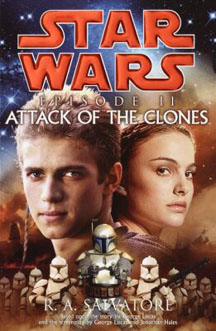Movies that have plot holes, shaky characterizations or structural problems are often sources for great novelizations, as the format allows for deeper exploration that may have been lost in the directing or editing process. More so than any other “Star Wars” movie novelization, “Episode II: Attack of the Clones” is ripe for this sort of improvement. Author R.A. Salvatore succeeds in one key area but generally falls short with a novel that can’t overcome the script’s boring first two-thirds any more than the film could.
Salvatore’s success, and it’s a big one, is the writing of the Anakin-Padme romance. In the film, when Padme tells Anakin she loves him right before they are to be executed on Geonosis, it doesn’t ring true. (At least one other “Star Wars” fan feels this way, as “Geek Out Loud’s” Steve Glosson remarked about the falseness of the line in a recent guest spot on “Fangirls Going Rogue.”) The line is so incongruous that for a while I theorized that Padme only said it because they were about to die, then perhaps fell in love with him during the ensuing battle when she decided life is too short to quibble about things like Senatorial and Jedi protocol.
The book makes it clear that she loved Anakin the whole time, just as Anakin loved her. Internally, she’s perhaps even more honest about her feelings than he is. On page 71 of the hardcover, Padme reflects on meeting Anakin again after a decade (in a rather PG romance-novel fashion, but in a way that makes it clear she has feelings for him):
Her mental eye roamed over his lean and strong frame, over his face, tight with the intensity that she had always admired, and yet with eyes sparkling with joy, with mischief, with … With longing? The thought stopped the Senator. … So it was all her imagination. Or was it her fantasy?
It’s also neat to read scenes of Anakin and Padme having dinner with Padme’s family on Naboo (some of which were among the “Episode II” DVD’s deleted scenes). Padme’s sister observing how Padme looks at Anakin is perhaps even more telling than the senator’s own thoughts, as illustrated in this exchange on page 180:
“Why do you keep saying such things about me and Anakin?”
“Because it’s obvious,” Sola replied. “You see it – you can’t deny it to yourself.”
Padme sighed and sat down on the bed, her posture and expression giving all the confirmation that Sola needed.
While the romance is merely poorly portrayed on film, “Attack of the Clones” also has many flat-out unanswered questions and unclear character motivations (despite the fact that George Lucas tries for a mystery element surrounding the Kamino cloners). And Salvatore fails to take advantage of the opportunities. For example:
- Why did Jedi Master Sifo-Dyas place an order for a clone army? My theory in 2002 was that Sifo-Dyas was an alias for Sidious (the names sound eerily similar), but later stories, such as “Darth Plagueis” and some Season 6 “Clone Wars” episodes reveal Sifo-Dyas to indeed be a Jedi.
- Why do the Tusken Raiders capture and torture Shmi? As Anakin says, “They’re like animals. And I slaughtered them like animals.” Almost every other story about Tusken Raiders, notably John Jackson Miller’s “Kenobi,” give them more depth than Salvatore does. This is despite the fact that Salvatore had the “Republic” arc “Outlander” to draw upon. (While the EU is now considered “Legends,” it wasn’t in 2002, nor in 2005 when Matthew Stover incorporated many EU references into his “Episode III” novelization.)
- What is Jango Fett’s backstory? The “Jango Fett” and “Zam Wesell” comic one-shots were on shelves before this book came out, so it would’ve been cool if Salvatore noted the attraction between the bounty hunters. It would’ve created compelling inner turmoil for Jango when he has to shoot Zam. “Jango Fett: Open Seasons” came out soon after the movie and fully told Jango’s backstory, but it would’ve been nice if the novel had peppered in hints of his colorful past.
And then there are the politics of “Attack of the Clones.” This material is ripe for an exploration of the inherent peacefulness of secession and the inherent aggression of forcefully keeping a union together, and the way that contrasts with the story’s notion that the secessionists are bad and the unionists are good. And perhaps Padme’s, or some of the Jedis’, struggles with this seeming incongruity. The build-up is too understated, in my opinion, but Salvatore delivers a nice punchline of sorts just before the Geonosian arena sequence.

In a scene that’s not in the film, Dooku outlines his stance to Padme on page 307:
“The Republic cannot be fixed, M’Lady. It is time to start over. The democratic process in the Republic is a sham. A game played on the voters. The time will come when that cult of greed called the Republic will lose even the pretext of democracy and freedom.”
Dooku’s argument, although strictly accurate, is then undercut by the fact that he’s willing to stand idly by as Padme, Obi-Wan and Anakin are executed by the bloodthirsty Geonosians. Padme thinks:
All she had to do to see through the lies, to see the fangs beneath the tempting sway of the serpent, was remind herself that he had taken Obi-Wan prisoner and meant to execute him.
I also like the succinct way Padme compares the Republic (a stand-in for the present-day United States) and the Separatists (an “alternative” that’s the same thing, but without the pretenses). As she tells Dooku: “What is happening here is not government that has been bought out by business, it’s business becoming government!” I find it interesting that the Trade Federation, the Commerce Guild, the Techno Union and the Banking Clan all are represented in the Confederation of Independent Systems government (and, for that matter, the Trade Federation was represented in the Republic Senate before it seceded). Perhaps the U.S. should adopt a transparent system such as this, thus cutting out the middlemen lobbyists.
While “Episode II” has nearly as many bonus scenes as Terry Brooks’ “Episode I” novelization, in general they don’t add as much. We see Shmi’s kidnapping and the horror felt by her husband Cliegg and stepson Owen, but that was already clear when we met them in the movie. I do like how Salvatore gives us more of Anakin’s slaughter of the Tuskens, though. It’s viscerally satisfying, and that puts us in Anakin’s shoes, thus challenging us to feel a bit of shame along with him. Both the Tusken slaughter and “Episode III’s” even more abhorrent youngling slaughter were stylized on film, allowing us to escape Anakin’s brutality.
Whereas Brooks – and later, Stover – made their assigned episodes their own, Salvatore writes cautiously, like a hired hand who doesn’t want to step on his boss’ toes. Brooks even skimmed over some scenes in “Episode I” to help his narrative flow. No such luck with “Episode II,” which could’ve benefited from excising the C-3PO hijinks on Geonosis – or at least from exploring the budding friendship between 3PO and R2 on the level of internal droid thought. I also hoped that Padme and Anakin’s adventures in the droid foundry – added toward the end of production when Lucas realized the middle act needed more action – would be left out of the novel, but no such luck.
By most accounts, the “Attack of the Clones” novelization can be skipped. However, if the Padme-Anakin romance is one of your favorite parts of “Star Wars,” I’d go so far as to say it’s a must-read – in that key area, Salvatore substantially improves on the film’s portrayal.

